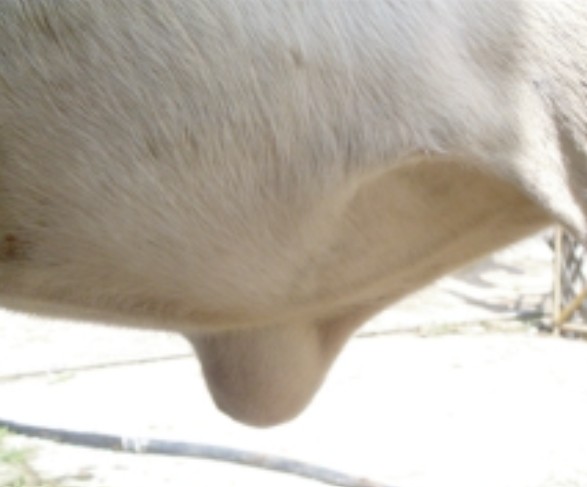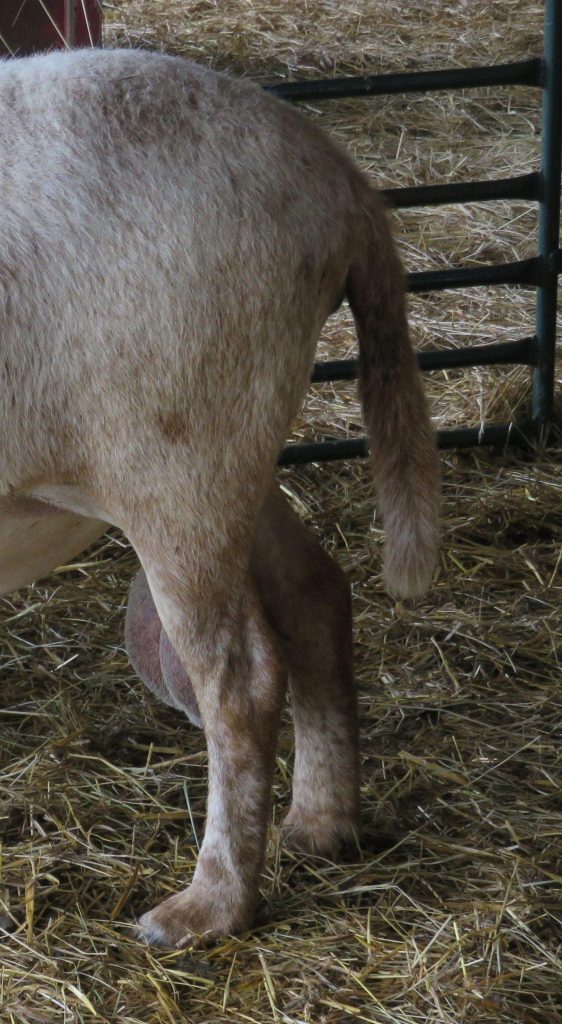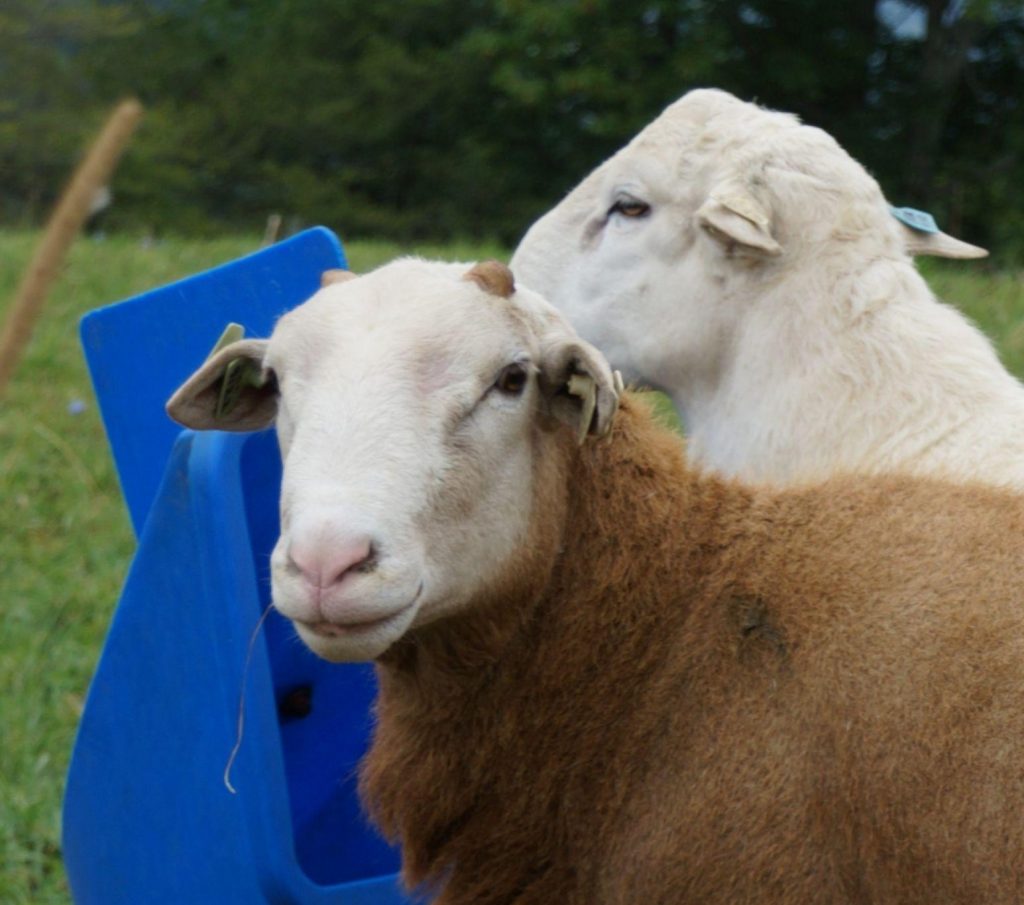Unfortunately, defects show up in some of our animals and even though those animals might be exceptional in other areas, for the betterment of the breed we should not propagate these defects. Always check your animals before keeping them as replacements or selling them as breeding stock.
Bite
In lambs the bottom teeth should “bite” into the dental pad. They should not extend in front of it (monkey mouth, undershot), nor be too far backwards (parrot mouth, overshot). If a bite is VERY off you can easily see that the bottom jaw is markedly longer or shorter than normal at a distance, however sheep that look normal from the outside can hide some abnormalities that you can only see by looking inside their mouths. It can get tedious to visually check a large number of lambs, so you can pre-screen by running your finger along the teeth, the tips of the teeth and the dental pad should feel level with each other. If it feels “wrong” you can do a visual inspection. Older animals can develop this as their teeth get longer when they age, but you definitely do not want to see this in lambs.
Animals with a bite defect are not able to bite off vegetation as well as animals with a normal bite. There is a genetic component to bite defects; so affected animals should not be used for breeding. If the animal is able to eat and maintain good condition they can be used to produce terminal lambs but for the betterment of the breed, this genetic defect should not be propagated.
The first two pictures show an undershot jaw and the next two are of an overshot jaw.




Note: Disease can be transmitted by opening the mouths of multiple animals one after the other. Wash or disinfect your hands between sheep to minimize disease transmission. I check bites on my lambs when I collect fecal egg counts, I put on a clean glove, check bite, and then collect the fecal sample. If you are looking at multiple animals at a sale, ask the breeder to show you their animals’ bites rather than checking them yourself.
Testicles
Rams should have two symmetrical, fully descended testicles that are of an adequate size. They should move freely in the scrotum and be firm, but not overly hard or soft. Any lumpiness detected on palpation is an indication of a serious problem. Testicles should be at a lower temperature than body temperature, otherwise sperm will be damaged and the ram’s fertility impaired. Testicle temperature is regulated by allowing them to descend deeper into the scrotum, and further away from the warm groin of the ram when it is hot, and being retracted up, closer to the body when it is cold.
Having a high fever will overheat sperm and render a ram infertile for 6-8 weeks after the fever event. The same can happen if a ram is exposed to extremely hot weather. Be sure to disclose this to buyers (or keep this in mind for your own breeding rams) as a whole breeding season can be lost if you use only one ram. A breeding soundness exam that includes semen evaluation will pick up on this.
Below is a chart from Purdue Extension (the full article can be found in the references below) showing the minimum scrotal circumference for breeding soundness by age of the ram. Gently push the testicles down into the scrotum and measure at the widest circumference, using a scrotal tape measure. Scrotal circumference changes throughout the year, and will usually be the largest in the fall (September- November). Adequate scrotal circumference is associated with being able to produce enough sperm to cover a reasonable number of ewes. There is also a positive association between scrotal circumference and early puberty in the ram’s daughters. There is an EBV for Scrotal circumference (PSC). While NSIP does not generate a percentile for PSC, larger is better. To give you an idea of the range for PSC EBVs, for 2024 born ram lambs that were tested in NSIP:

Maximum 3.9cm
75th percentile 2.2cm
50th percentile 1.8cm
25th percentile 1.3cm
Minimum -1.5cm
| Age in months | Minimum scrotal circumference in cm |
| 5-6 | 29 |
| 6-8 | 30 |
| 8-10 | 31 |
| 10-12 | 32 |
| 12-18 | 33 |
| 18+ | 34 |
Rams with retained testicles can be cryptorchid (both testicles are retained, either in the abdomen or under the skin, but not in the scrotum) or monorchid (one testicle in scrotum and the other retained). Retained testicles cannot move because they are not in the scrotum, especially testicles that are retained in the abdomen are at a temperature that is not compatible with good sperm quality. Cryptorchid rams are theoretically sterile, but remember Murphy’s Law: the cull cryptorchid ram you’re raising for slaughter will likely escape and be fertile enough to breed all your ewes. Partial or fully undescended testicles should disqualify a ram from breeding because it impedes fertility and is heritable.
The photos below show rams with only one descended testicle


There is an opening called the inguinal ring that communicates between the abdomen and the scrotum. Each testicle passes through their respective rings during gestation to end up in the scrotum. Testicles receive their blood supply from vessels in the abdomen that pass through this ring, so a small opening needs to remain. When the opening in the inguinal ring is too large intestines or fat can pass into the scrotum causing a scrotal hernia. Scrotal hernias are usually one sided and can make the scrotum look abnormally large, but without the definition of a testicle in the scrotum, just a big blob. If intestines are caught up in the hernia, the ram will be sick and die soon, if the hernia is not repaired. If only fat is caught up in the hernia the ram will not die, but he will grow more uncomfortable over time.
The photo below on the left shows a scrotal hernia in a live ram, the ram was euthanized due to growing more and more uncomfortable over time. The photo on the right is post mortem. The red, meaty band is the inguinal ring, you can see the testicle on the bottom right and all the fat to the left of it was caught up in the hernia.


Intersex (hermaphrodites)
Although rare, sometimes what appears to be a ewe lamb can develop testicles. They tend to have abnormal vulvas, grow big and muscular like a ram and some even grow a mane. What most shepherds call a hermaphrodite, and what is shown in the pictures below is technically a male pseudohermaphrodite.
This is a developmental abnormality and is not heritable. Affected animals are not able to reproduce, so you do not have to worry about propagating this defect. You should check for it though so you can market them for meat while still lambs. You (and your customers) will be very disappointed if you retain or sell them as breeding stock. Affected animals can be used as teaser rams (no surgery required) but do not make good pets as they have the same hormones as rams.


Umbilical Hernia
During gestation the lamb has an opening in its abdominal wall that the umbilicus passes through. After birth this opening should close up and once the umbilicus is dried up and falls off, there should be no opening left in the abdominal wall. Sometimes though, the skin closes up but an opening in the abdominal wall remains. If the opening is really small, only fat can pass in and out, but if the hernia is larger, then intestines and even organs (in really large hernias) can pass through and be seen and felt between the skin and abdominal wall. In general,, the material between the skin and the abdominal wall can be pushed back into the abdominal cavity and the opening in the abdominal wall can be felt.

When a hernia is big enough for empty intestines to pass through, but not to allow them to pull back into the abdomen when they become filled with gas, then the intestines become trapped, their blood supply is compromised and animals will die, if not treated.
This is a photo of an umbilical hernia in a calf. Photo source: https://pubmed.ncbi.nlm.nih.gov/19934601/
Animals with umbilical hernias should not be used for breeding. A ewe with a hernia will have extra pressure applied by lambs and a uterus pushing down on it. There is an increased chance of intestines being forced into the hernia due to the pressure. As the abdominal wall stretches out when the fetus is growing, there is also an increased chance of the hernia enlarging. Umbilical hernias have a heritable component to them, so even though they can be surgically repaired, rams and ewes with umbilical hernias should not be used for breeding.
Pasterns


Pasterns should be angled correctly to be able to support a sheep’s body weight properly. Weak pasterns are caused by a combination of a longer pastern bone as well as too wide an angle of the joint. In the long run this puts excessive strain on this joint and tends to get worse as an animal ages. In rams the back pasterns take a lot of strain during breeding and weak back pasterns can lead to lameness and a much shorter usable lifespan for a ram. Ewes gain a lot of weight during gestation and weak pasterns take a lot of strain and might shorten a ewe’s productive lifespan.
Pasterns that are too upright lose their shock absorption function and this can lead to injury of this joint or joints further up the leg.
Conformation traits are very heritable so poor pastern structure will be passed on to a ram or ewe’s offspring.
Poll Type
Not being polled is not a genetic defect and it is allowed in the Katahdin breed standard. Katahdins have horned sheep in their ancestry so horned sheep occasionally pop up. Scurs are much more commonly seen in Katahdins.
The Katahdin Breed Standard states: Polled animals are preferred; horned and scurred individuals are recorded as such. Polled-ness is preferred, but horns and scurs are acceptable.
There are three polled-ness possibilities:
Polled – when you look and feel in the horn bud area, there is no horny tissue
Scurs – when you look and feel in the horn bud area, there is horny tissue. This tissue is movable and not attached to the skull. Scurs can be small enough to not show above the hairline, or could be large enough to be seen without having to part the hair. Scurs can stay small or enlarge as the ram grows older.
Horns – when you look and feel in the horn bud area, there is horny tissue that is attached to the scull and not movable. Horns will get bigger as the ram ages.
In cattle Horned vs Polled genetics are determined by one set of genes with Polled being dominant (as long as you have one polled gene, you will not have horns). There is a different set of genes that determine scurs. Scurs can only be expressed in polled animals as horned animals have horns and you cannot have horns and scurs at the same time. Unfortunately, the inheritance of scurs and horns in Katahdins has not really been studied, so it is hard to know what a ram will produce in his offspring. Rams with scurs produce more scurred offspring than rams that are polled.

This ram in the picture at right has scurs. They were present, just showing at his hairline at six months old, but by 12 months old he looked like this.
Even though horns and scurs are acceptable, they can be a pain to deal with. When scurs are big enough to extend above the skull they can break off and cause bleeding . Even though the scur itself is like a fingernail that does not have a blood supply, the tissue that it is attached to can be torn when scur breaks off. Horns can get caught in feeders and fencing and most people do not want to deal with those. This is a personal preference whether you want to deal with horns or scurs. Horned sheep can be dehorned, just like any other species with horns. If you dehorn a lamb, be sure to disclose this to buyers, as he will likely have more horned offspring than a naturally polled animal.
Conformation Defects according to the Katahdin Breed standard:
- Over-or undershot jaw
- Very light bone structure
- Weak shoulders or back
- Cow- or sickle-hocked legs
- Weak pasterns or splayed hoofs
- Cryptorchidism or monorchidism
- Extremely small testicles
- Missing or malformed teats
More information about defects and conformation can be found
- https://easternalliancekatahdins.com/three-common-genetic-defects-to-look-for-when-buying-or-selling-sheep/
- https://img1.wsimg.com/blobby/go/eeca51b5-0239-4a42-b168-64e9709a7631/downloads/Guide%20To%20Breeding%20Stock%20Selection.pdf?ver=1689259330708
- https://www.slideshare.net/slideshow/conformation-101-64679217/64679217
- https://www.extension.purdue.edu/extmedia/as/as-599-w.pdf?fbclid=IwY2xjawKyUNhleHRuA2FlbQIxMABicmlkETFkZTRJVHlFM09xU2lmRlJWAR7dB3iuG76ZMHgu37001l26mHxyAjMaIjQW7VuCYv9z1AeQXQEKK5nuKpWjdg_aem_Q_-AO-SFY6YG6IJZKgm64Q
- https://www.merckvetmanual.com/reproductive-system/congenital-and-inherited-anomalies-of-the-reproductive-system/intersex-conditions-of-animals
By: Isabel Richards, EAPK Communications Committee
![]()

